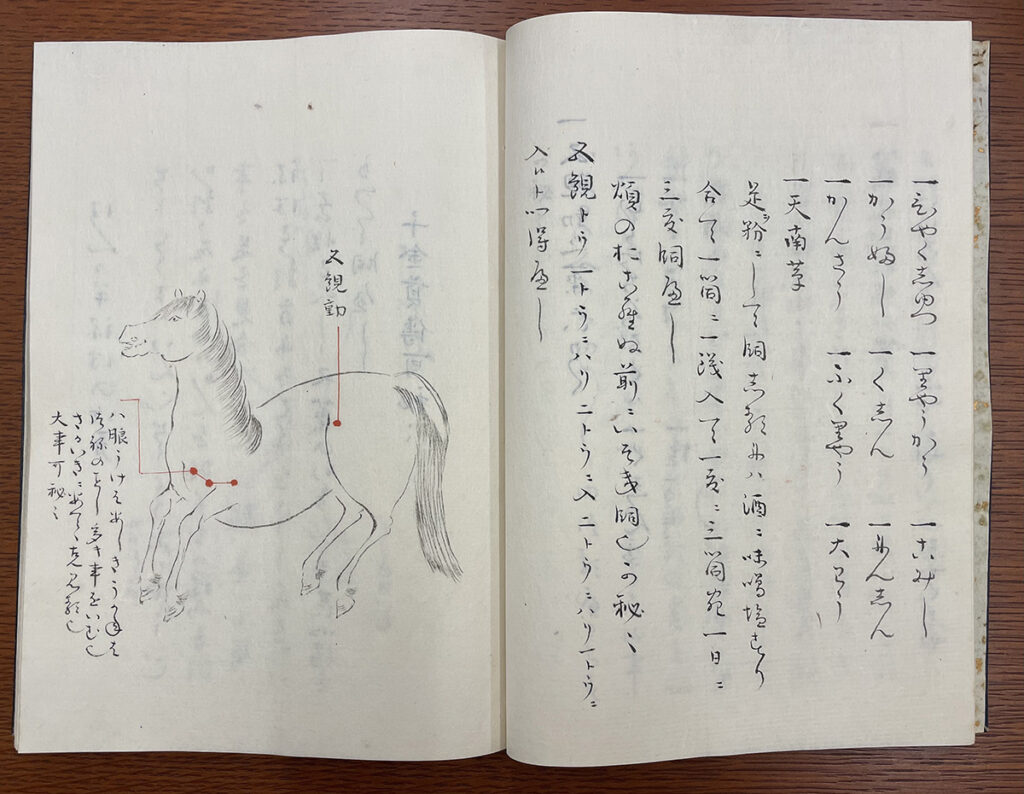Original images held by the Harvard-Yenching Library of the Harvard College Library, Harvard University
Tanaka ke hidensho, 1800-1867 (bulk), Vernacular title: 田中家秘傳書 Variant title: Equine medicine, Tanaka family; Secret writings of the Tanaka family. Manuscript
Summary written by Juhee Kang (Ph.D. Candidate, Department of East Asian Languages and Civilizations, Harvard University)
 Tanaka de Hidensho consists of twelve bound booklets, all concerning the management of horses in the seventeenth century. Based on the present kuzushiji cursive styles, the twelve booklets can be divided into three compositions, indicating three distinct manuscripts. Each composition expounds on various topics, ranging from successful breeding cases for different types of horses, their diet, the maintenance schedule for equestrian items (hooves, whips, and coats), to the medicinal recipes and other therapeutics (such as acupuncture) to treat equine diseases. While the exact identities of authors and compilers need further verification, we can recognize multiple sources comprising the Tanaka family collection.
Tanaka de Hidensho consists of twelve bound booklets, all concerning the management of horses in the seventeenth century. Based on the present kuzushiji cursive styles, the twelve booklets can be divided into three compositions, indicating three distinct manuscripts. Each composition expounds on various topics, ranging from successful breeding cases for different types of horses, their diet, the maintenance schedule for equestrian items (hooves, whips, and coats), to the medicinal recipes and other therapeutics (such as acupuncture) to treat equine diseases. While the exact identities of authors and compilers need further verification, we can recognize multiple sources comprising the Tanaka family collection.
 Tanaka de Hidensho would be invaluable primary sources for scholars interested in the early modern history of Japan and East Asia, animal studies, and specialty literature, among others. Horses in the Tokugawa period (1603-1868) were not only rare but also played critical functions. They were integral to the shogunate’s military strategy, serving as essential assets for samurai warriors and playing a crucial role in warfare and transportation. The Tokugawa period also saw the development of specialized breeding programs to enhance horse quality, reflecting the high value placed on these animals. Horses served as symbols of prestige and power, often exchanged as gifts between daimyo (feudal lords) to strengthen political alliances. The presence of horses influenced the rural economy, as their maintenance and breeding supported various industries, including agriculture and trade, thereby shaping the social and economic landscape. Families designated with the authority and responsibility of managing horses kept their knowledge secret and inherited it through apprenticeship and practice. Tanaka de Hidensho thus provides a rare site where these generational secrets as well as the bodily knowledge accumulated by “horse doctors,” were systematically organized and written down.
Tanaka de Hidensho would be invaluable primary sources for scholars interested in the early modern history of Japan and East Asia, animal studies, and specialty literature, among others. Horses in the Tokugawa period (1603-1868) were not only rare but also played critical functions. They were integral to the shogunate’s military strategy, serving as essential assets for samurai warriors and playing a crucial role in warfare and transportation. The Tokugawa period also saw the development of specialized breeding programs to enhance horse quality, reflecting the high value placed on these animals. Horses served as symbols of prestige and power, often exchanged as gifts between daimyo (feudal lords) to strengthen political alliances. The presence of horses influenced the rural economy, as their maintenance and breeding supported various industries, including agriculture and trade, thereby shaping the social and economic landscape. Families designated with the authority and responsibility of managing horses kept their knowledge secret and inherited it through apprenticeship and practice. Tanaka de Hidensho thus provides a rare site where these generational secrets as well as the bodily knowledge accumulated by “horse doctors,” were systematically organized and written down.


